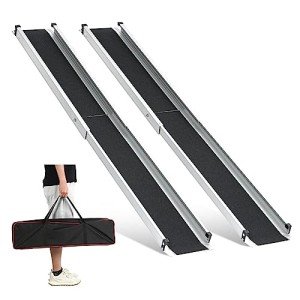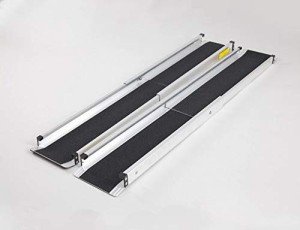In a world where accessibility and mobility are fundamental rights for everyone, wheelchair ramps play a crucial role in facilitating movement for individuals with limited mobility. Among the various options available, the adjustable aluminum wheelchair ramp measuring 244 cm in length has gained attention due to its unique features, versatility, and ease of use. This guide delves into the benefits, specifications, installation, and maintenance of this essential mobility aid, while also addressing common questions regarding its use.
What is an Adjustable Aluminum Wheelchair Ramp?
An adjustable aluminum wheelchair ramp is a specially designed device that allows individuals who use wheelchairs to overcome obstacles such as stairs, curbs, and doorways with ease. The adjustable feature allows users to modify the height of the ramp to accommodate various inclines and surfaces, making it a flexible solution for different scenarios.
Key Features of the 244 cm Long Adjustable Aluminum Wheelchair Ramp
-
Material Quality: Made from lightweight yet durable aluminum, these ramps are resistant to rust and corrosion, making them suitable for both indoor and outdoor use.
-
Adjustable Height: The adjustable mechanism allows users to set the desired incline, which is especially important for ensuring safety and ease of use.
-
Portability: This ramp often comes with a folding design, enabling easy transport and storage. Its lightweight nature ensures that caregivers can carry it without much hassle.
-
Non-Slip Surface: The ramp is typically designed with a non-slip surface or traction features that enhance grip, minimizing the risk of slips and falls.
-
Weight Capacity: Many adjustable aluminum ramps can support significant weight, often accommodating users and their mobility devices totaling up to 800 pounds or more.
-
Versatile Applications: Whether for home use, public spaces, or vehicles, the 244 cm ramp can be used in a variety of settings, making it a flexible mobility solution.
Benefits of Using an Adjustable Aluminum Wheelchair Ramp
-
Enhanced Accessibility: One of the primary benefits is that it allows individuals with mobility challenges to access homes, public buildings, and vehicles without assistance.
-
Safety: With adjustable height and non-slip features, these ramps provide a safer option for navigating various surfaces and inclines.
-
Ease of Use: The ramp can be positioned quickly and easily, making it user-friendly for both the individual using the wheelchair and their caregivers.
-
Cost-Effective: Investing in a high-quality adjustable ramp can be more economical in the long run, reducing the need for costly permanent adaptations to properties.
-
Customizable Solutions: The ability to adjust the ramp's height means it can be tailored to fit a wide range of environments and user needs.
Installation Process
Installing an adjustable aluminum wheelchair ramp is typically straightforward and can be accomplished with minimal tools. Here’s a brief step-by-step guide:
Steps to Install
-
Select the Location: Identify the area where the ramp will be used, ensuring that it offers a stable surface and allows for a gradual incline.
-
Adjust the Height: Before installation, adjust the ramp to the desired height based on the location's needs.
-
Secure the Ramp: Place the ramp at the designated entryway or vehicle. Ensure that both ends are stable and secure against the surface.
-
Test the Ramp: Have the user or caregiver test the ramp to ensure it supports the appropriate weight and maintains stability during use.
-
Regular Maintenance Checks: Periodically inspect the ramp for any wear and tear, particularly the adjustable mechanism and the non-slip surface.
Maintenance Tips
Maintaining an adjustable aluminum wheelchair ramp is essential for safekeeping and operational efficiency. Here are some tips:
-
Regular Cleaning: Clean the surface with mild soap and water to remove any debris or buildup that could compromise traction.
-
Check for Damage: Routinely inspect the ramp for cracks, bends, or wear, particularly at the joints and adjustable mechanisms.
-
Lubrication: If the ramp has adjustable features that require a locking mechanism, ensure these components are well-lubricated to avoid rust and sticking.
-
Store Properly: When not in use, store the ramp in a dry environment to prevent corrosion and degradation.
Frequently Asked Questions (FAQs)
1. How steep can the incline be for the adjustable aluminum ramp?
The maximum incline for wheelchair ramps is typically 1:12 for motorized wheelchairs and 1:8 for manual wheelchairs. However, the adjustable feature allows users to select a comfortable incline based on their capability.
2. Can the ramp be used for vehicles?
Yes, many adjustable aluminum ramps are designed for vehicle use, enabling individuals to easily access vans or SUVs equipped for mobility needs.
3. How much does a 244 cm adjustable ramp weigh?
The typical weight of a 244 cm Aluminum Wheelchair Ramp ranges from 30 to 50 pounds, depending on its specific design and structural features.
4. Are there age restrictions for using the ramp?
There are generally no age restrictions; however, caregivers should oversee younger users to ensure safety while using the ramp.
5. Is a permit required for permanent installations?
Some areas may require permits for permanent installations or significant alterations to properties. It’s advisable to check local regulations.
The adjustable aluminum wheelchair ramp measuring 244 cm in length is an invaluable tool for enhancing accessibility and independence for individuals with mobility challenges. Its adjustable height, lightweight design, and safety features make it a versatile choice for a variety of environments. By understanding its benefits, installation process, and maintenance needs, users can ensure a seamless experience that empowers them to navigate their world with confidence and ease.







